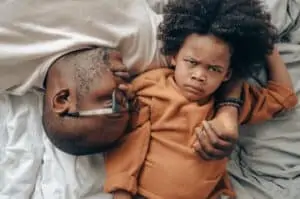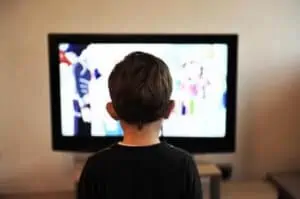I vividly remember my bestie telling me how happy she was when Violet, her daughter, turned 3. “Hahaha! Now we’re out of the terrible twos! I’m so excited!”
And excited she was. But not for long.
The terrible twos and threes that follow those twos are enough to test every shred of patience and sanity you have.
I tend to think the terrible 3s are worse. Because this is the time when kids stop taking naps. They ask “why” all the dang time. They are picky as all heck about food, even foods they usually ate without batting an eye before this.
Oh yeah, and let’s not forget they’re potty training and tend to have more epic meltdowns than they did at the age of 2.
Violet was about to drive my bestie right to the funny farm. But fortunately, she got a handle on it.
My Own Encounters with the Terrible 3s
I could probably go on for years and years detailing my encounters with terrible threes symptoms like the ones above. My eldest notoriously loved eggs. She would gobble them up. Shrimp too!

When we lived in China, my mother-in-law would make them special for her and sit proudly, admiring what a good little thing she was.
Then, not long after we celebrated her 3rd birthday, Grandma got an earful.
Screams and tears over the food she had loved just days before. Suddenly, she didn’t want shrimp or eggs. My mother-in-law scrambled to find something she would eat. All she wanted was bread.
There was a time she told my father-in-law she wasn’t tired. She didn’t need a nap. But she was acting tired. He tried to do everything to get her to sleep. He even lay next to her on the bed.
Guess what happened?
He fell asleep, but she didn’t. And she took the opportunity to eat every last piece of chocolate from this big thing he’d brought along as a treat for her. Every. Last. Piece.
She was then like a demonic chihuahua running through the home. I had never been so grateful to be at work at the time.
My eldest isn’t the only one, either. My youngest was a hot mess during her terrible 3s. Her terrible threes tantrums were mostly about the toilet, though. She was oddly never a great napper.
Oh! And her hair! Yes! I almost forgot she would freak out about her hairstyles. She’d completely go bonkers. I could offer to style her hair with any style under the sun, and she’d still whine, wail, and cry like we were ripping her limb from limb.
So, what comes after the terrible twos? The terrible threes, of course. I’ve heard this phase referred to as a “threenager” but you can call it anything you like because it’s still one of the biggest challenges you’ll face as a parent. Hands down.
Are threes worse than twos?
Well, that depends on who you ask. Terrible 3s are generally worse because your child clashes with what they have learned and how their minds develop. They can communicate better now at age 3. But they don’t have more emotional maturity.
So you’ll get things like, “I don’t want to sit in that chair!”
“Ok, why not?”
“I don’t know!!!”
And it will all make perfect sense. To them, anyway.
When do the terrible twos end?
I once knew an expat when I lived abroad. I really tried to be nice to everyone, but she acted like she was better than all of us. She’d boast in the parent groups about how great her 2-year-old daughter was. “She never does that,” she’d say, looking disapprovingly over at any of us with kids that happened to be crying or throwing a tantrum.

Even when her daughter turned 3, she still smugly sat there. But that didn’t last long. It was hard not to laugh when her “angel baby” turned into a nightmare on wheels. Literally.
She took the toddler car and ran (or should I say drove?) from her mom, who ran after her. Suddenly her perfect life wasn’t so perfect anymore.
Anyway, there is no clear ending or beginning. One day it will happen, and then it will end. Just buckle up and get ready for it. And make sure you don’t judge other parents as they go through it, too, even if you’re not there yet. Those of us who have been there KNOW. That’s why I always offer to help mamas I see at the supermarket struggling not to go completely insane. I’ve been there.
Signs you’ve entered the terrible threes
So, how do you know your child is in terrible 3s territory?
- There’s lots of screaming. LOTS! Like they forget how to talk.
- Every request you make is met with stomping feet.
- And every request, no matter how reasonable, is met with defiance. “We’re going to Grandpa and Grandma’s. Please put your shoes on.” “I DON’T WANT SHOES!!!!!”
- You will hear “NO” about just about everything.
- They’re not hungry for food – things they loved to eat before they turn their noses up. Oh, but it will be happily consumed if it’s candy, cookies, or cake. Then you’ll have a sugar demon on the loose.
- Getting dressed and having simple grooming habits are an ordeal.
- Tantrums. Yes, lots.
- Yes, in the grocery store too.
- Yes, everywhere.
That about sums it up!
How do you deal with terrible threes and defiant behavior?
Putting up with the terrible threes is exhausting. But you have to understand where it’s coming from.
For example, I remember my eldest acting bratty in the store when we were in China. It signaled something familiar in my head. “Did you need to go to the bathroom?” I asked her. She looked around uncomfortably and nodded her head. I took her, and I realized I solved some of the causes of tantrums.
See, they can communicate better at 3 though they are not mentally equipped to handle all they know. It’s like those closets in the movies where everything falls out when you open the door, and it’s a huge mess. That’s a 3-year-old’s mind. If you don’t know why this is difficult to deal with a 3-year-old, read here.
So do know that it comes from a place of confusion. That said, you need some tips to handle this, so you don’t run down the street flailing your arms like Cameron Diaz in Very Bad Things.
Don’t fight it out over everything
Just like we learn with our spouses, picking battles is important. Focus on the dangerous, ultra-annoying behaviors, or not even slightly civil, which will give you a better way to bargain with the terrible threes.
Tempting as it is to bite your child back that bit you to show them how much it sucks, DON’T! You’re just teaching them this is an acceptable way to behave.
Timeout is good for behavior like biting. Make sure you don’t make idle threats either, or your child will continue to be a terror. When we’re not consistent, it makes things even more confusing for our kids, and as I’ve explained, this is already a confusing time in development for them.
Plan ahead
Your child has a certain rhythm. Watch how it goes. If she’s energetic in the morning but tired and grouchy after lunch, plan your days so that you’re going places as much as possible when she’s in her good mood. Sometimes, it can’t be avoided, but it will reduce upset.
New experiences can be scary for children, so plan too. When my eldest was little, we took her on several plane rides. The first one, we explained to her what was going to happen. I started talking to her weeks in advance. I showed her airplanes, hotels, sights we’d see, and all kinds of things.
While it didn’t stop all tantrums (she had a few when she was exhausted), it did keep her from flipping out over the newness of everything.
Keep calm, and Mama, on
Sooner or later, everyone goes to the zoo. One of my favorite movie lines of all time, but it’s very true. There will be moments when the terrible 3s will rise with horrid behavior. But you must stay calm and face it directly.
The key is to feign calmness on your exterior even if you want to scream OMGSTFU. You must stay positive, like a Disney employee with a great big, welcoming smile and a kind voice.
My youngest turned into a mess while visiting family during her terrible 3s. We were trying to sit down to eat; believe me, I was hungry, but I had to deal with her. Instead of barking commands like, “Sit down this minute!” Or “Go wash those hands right now!” I framed it as a suggestion like this, “Why don’t we wash our hands together, and then we can sit down with everyone for a lovely dinner?” It’s the way you suggest it that does the trick.
Another trick for you: use “Do” more than “Don’t.” Positive attracts positive, so always think positively when dealing with terrible threes tantrums. If you say, “Please use an inside voice” rather than “Don’t yell,” it tends to go over much better.
Open your ears
I even remember feeling like no one was listening to me as a child. I’ve found that it has a better effect when I repeat what my children say (even now when they’re much bigger). I started doing this when my eldest was 3.
Mirroring back their concerns helps them feel validated. But when combined with the next tip, it really works wonders!
Choices are king
Along with not feeling heard, children at this age feel like they have no control. Obviously, you can’t just let your child do as he or she pleases. But you can make them FEEL like they have control.
A prime example is the shoe situation. I don’t know why but it seems every 3-year-old has a problem with shoes. Perhaps it’s been going on since caveman days, but in any event, give them a choice instead of having that drama about shoes.
“Would you like to wear your sneakers or pink flats to Grandma’s house?” This is a much better way to handle the terrible 3s. This makes her feel like she’s got a say in what’s going on.
I used the choice thing so much. Just make sure you offer choices that are safe, reasonable, and you can deal with them. For example, you wouldn’t offer soccer cleats as one of the options for going to the store.
Help them learn to problem-solve
Your three-year-old is learning to express herself with all these emotions while trying to piece everything else together. Help her with this by confirming her feelings are hers and that they are ok but must be expressed correctly.
My youngest would get angry about things like losing Candyland. I’d tell her, “I know you’re angry because you didn’t win the game. I don’t like losing, but maybe we can find another way to express anger without throwing the game at your sister.”
It will take time and patience on your part, but your child will learn that having emotions – even negative ones – is ok. And that when it comes to these emotions, there are safe and better ways to express them then acting out and hurting someone.
Lead by example
When you mess up, use it to show your child that even Mommy makes mistakes. This helps your child see it’s ok to make a mistake and how to move forward from them.
Use rewards appropriately
And finally, rewards are great when they’re not bribes. You can have your child earn rewards for behaving well. What worked for me as a child (and for my kids at that age) was the promise of dessert.

I was highly trained to behave in restaurants. I still remember people stopping by our table on the way out of restaurants when I was little to praise my parents for being such a well-behaved child.
Why did I sit well and eat my food nicely? Because if I didn’t, I wouldn’t even get a chance to look at the dessert menu.
I will say that you should be kind to little ones if you have them out to dinner. They’re likely tired, and that can lead to undesirable behavior. If your child lies down on the bench seat at the booth and is quiet, don’t make a fuss. Let them rest and know you’re so proud they’re being so good, and if they continue, they’ll get to join you out to dinner more often and have dessert too.
Final Thoughts on Terrible 3s
One day, you’ll look back and laugh at these times. It’s not all smooth sailing, but we’ll figure it out together. Just take each moment as it rolls in, and try not to let that threenager ruffle your feathers!
Leslie Berry lives with her husband and two young daughters in Los Altos, California, where she loves helping other moms get comfortable with motherhood and embracing the insanity with facts peppered with laughs.
She loves eating too much sushi, exercising, and jamming out on her Fender. Read more about Leslie here.





